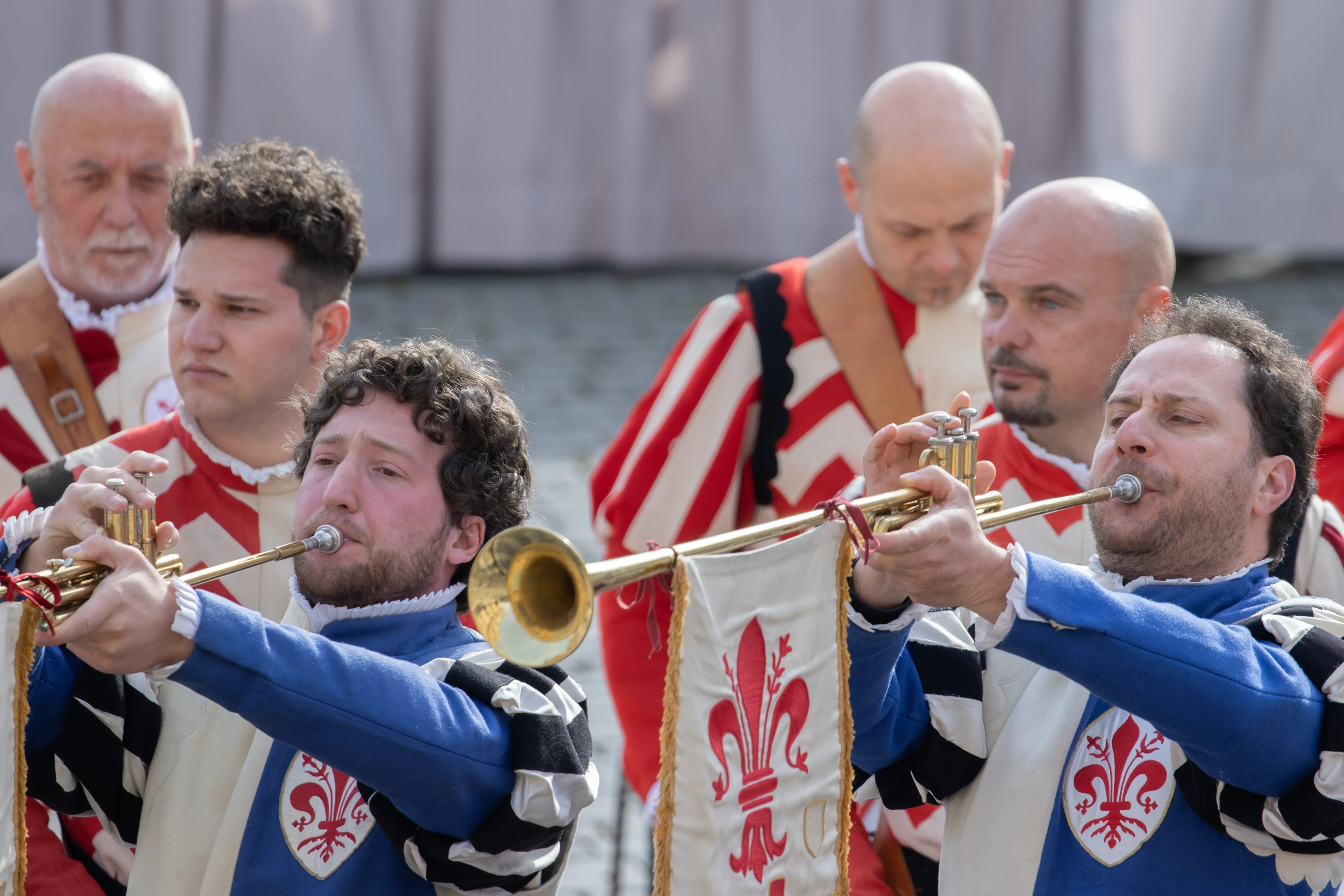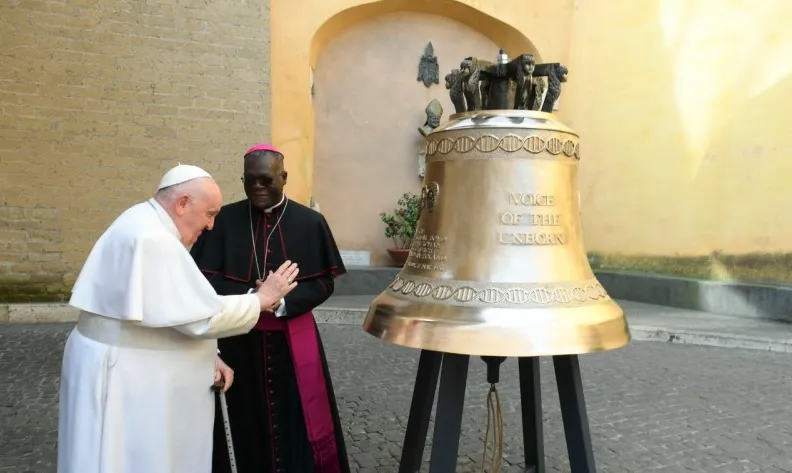
If you had visited Soho Square in the center of London on a recent Saturday night, you would have seen something unusual.
There is a Hare Krishna monastery just off the square. Each weekend, the monks march around it with drums and cymbals, chanting to honor their founder. They are as loud and raucous as the other, less spiritual, visitors to Soho—a quarter most Londoners associate far more with vice than virtue.
That night, awaiting the marchers, were two Catholic religious—two Sisters of Life, to be exact.
The sisters stood on the square, holding lighted lanterns, as the crowd of chanting Hare Krishna approached. The sisters stood praying quietly as the noise of the oncoming throng grew steadily louder and nearer. By this point, the Hare Krishna had spotted the two sisters. The saffron-robed figures drew closer still; and, observing all this from a short distance away, I also knew that the chanting would soon fall silent.
My first encounter with the Sisters of Life was by accident.
A few days earlier, I had wandered from the Thames Embankment northward to one of the few churches that I knew would be open at that late hour, St. Patrick’s Church, Soho Square. This is a church whose parish boundaries encompass much that is representative of the Culture of Death. And yet it stands, as it has done for more than a hundred years, a sign of witness to all who pass by or who, on occasion, drop in to pray. Adoration of the Blessed Sacrament is a key feature of the life of this parish, continuing for many hours each day.
To my surprise, on arrival at its great doors that weekday night, I saw that there were many people already in the church. I entered as a bishop was addressing all present. At this point, I didn’t know who the prelate was—later I discovered it was Bishop Egan of Portsmouth. Suddenly, a voice with a North American accent was filling the church; it spoke of the founding of a religious order.
The person speaking was Sr. John Mary of the Sisters of Life. She and another Sister of Life, Sister Claudia Marie, had travelled from Toronto to attend the annual Theology of the Body Symposium for young adults held at St. Patrick’s.
Intrigued by what I heard, I returned the next day to meet the Sisters of Life.
The first thing that attracted me to the sisters was their joy. And yet the people with whom the sisters work in North America—as yet they have no convents in Europe—are often far from happy. The sisters bring life to a culture that is in love with death; and death, or the threat of death, is something the sisters encounter on a daily basis. Pregnant but unhappy mothers, or those who have undergone abortions and later feel regret, all turn to the Sisters of Life.
In today’s culture this work is sadly never-ending; but there are women who feel called to it. At present, the Sisters of Life have 30 young women in formation. This number of vocations sets them apart from so many other religious communities that are declining in numbers. What also sets them apart is the fact that this community started with a newspaper advertisement.
In 1991, the following appeared in a New York newspaper: “Help wanted: Sisters of Life.” Eight women responded to it—the beginnings of a religious community.
The story goes back further than the newspaper advertisement; in fact it goes back to a concentration camp. The man who placed the advertisement was New York’s Cardinal John O’Connor. He had visited Dachau, the site of mass murder by the Nazis. While there, the cardinal placed his hand in one of the crematoria to feel the dust within. As he did so, it struck him that here were the remains of men and women, Jew and gentile, young and old, rabbi and layperson, Christian priest and religious—that here was evidence of the reality of a culture of death, and that this culture of death persisted yet, if perhaps in more hidden ways than in the 1940s. It was from that experience that the idea came to Cardinal O’Connor to found a religious order dedicated to a civilization of love.
Today, the Sisters of Life number more than 100. Their growth is a testament to grace as well as the timeliness of what they offer.
For the first time, two of the sisters had come to England in an official capacity. Prior to entering religious life, both Sr. John Mary and Sr. Claudia Marie had visited London. In fact, Sr. Claudia Marie had lived here for several years. Both sisters are Canadian; but their stories are very different.
Sr. John Mary grew up in Calgary. After university, she found herself working at the United Nations in New York City. Her interest was public policy, with the desire to build a better society. Back then she had no inkling of a religious vocation. Nevertheless, from a young age, she was passionate about helping people, and she was an idealist. After a chance encounter with the Sisters of Life in New York, she began to reevaluate her life’s direction. Soon after, she started to discern a call to take a radically different path.
Although she was brought up in a devout family, her choice of order required a large act of faith from them. It was such a new order and so different from the types of religious orders then in existence. The call persisted, though, and so too did Sr. John Mary’s response to it; after Cologne’s World Youth Day in 2005, her mind was made up definitively.
Sr. Claudia Marie had a nominal Catholic upbringing that had given way to an adult search for truth among the world’s religions. This could have proven dangerous for her faith; mercifully, the search was cut short by a dramatic intervention. With a youth group intent on making a film, Sr. Claudia Marie had climbed a mountain. While sitting on top of it and looking out at the breathtaking view, she underwent what she describes as a mystical experience. When she came down from the mountain all other “gods” had been dashed against the truth of what she had experienced. The Holy Spirit had entered her life in a radical way and, by so doing, began to lead her into a more complete truth.
Interestingly, the journey that followed brought her to London, and to St. Patrick’s. It was a happy coincidence, therefore, that years later, she returned to that church to form a new generation in the truths of Pope John Paul II’s Theology of the Body.
The Symposium on the Theology of the Body was, as one would expect, full of lectures and workshops, discussions and fellowship, but there was something else besides. At the center of the four days was Eucharistic Adoration, taking place in the church as the symposium continued in the conference rooms below.
On Friday night, there was a healing service. Each person was invited to come forward to the altar rail and receive a blessing with the Eucharist in a monstrance, held in the hands of a young deacon. In the softly lit church it was both a powerful and moving experience to see so many come forward to receive this blessing, and to watch as each laid down their burdens or had wounds healed under the loving gaze of the Risen Lord truly present in the Sacrament.
St. Patrick’s has a novel approach to evangelizing the area in which it is situated. Its parishioners go out to the highways and by-ways to invite all they meet to come into the church to pray. This takes place on periodic Saturday nights and is called Night Fever. On these nights the church is lit mainly by candlelight, with the Blessed Sacrament exposed on the altar; hymns are sung and adoration continues by those remaining to pray while teams of two or three leave the church, some carrying lanterns with lighted candles as they go into the streets with an invitation.
In anticipation of that night’s proceedings, I had taken a walk around those same London streets. They were as noisy as I remembered them. They were also full of people, all intent—with a seriousness that alarmed—on having a “good time.” It is enough to say that I saw the Culture of Death in numerous manifestations. I could only reflect that the spirits that hold sway in that neighborhood were not the same as the one Spirit that had pervaded the symposium and which now led some of its attendees out onto those streets.
Later that evening, I found myself in the company of Sr. John Mary and Sr. Claudia Marie, back on those same streets. I expected the sight of these nun to be met with incivility, hostility even. I feared for these polite and charming Canadian nuns about to confront some of the worst aspects of secular London.

As it transpired, I had underestimated the Sisters of Life. Their ready smiles attracted people. There was a curiosity, especially from young women, coupled with an instant desire to speak to these sisters in religious habit. I watched as a group of young female partygoers walked toward the two religious. The young women were obviously well into their night out; the sisters invited them to go to St. Patrick’s and light a candle and offer a prayer before the Blessed Sacrament. I watched as, minutes later, arm-in-arm with the sisters, this noisy group of young women, dressed for a nightclub rather than a church service, entered St. Patrick’s. Soon after, that same group was kneeling in prayer at the front of the church. And in the candlelight, I noticed it was not just prayers that were offered, but also tears.
In the end, there were few who refused the invitation of the Sisters of Life and the others to come into the church to pray. Tourists and revelers, the drunk and sober, the young and old, responded to the invitation. There were those who came sniggering at what was being proposed—initially, at least—but then looked changed, more thoughtful, chastened even, on their leaving.
This was the New Evangelization using a very old method: apostles bearing a personal invitation. Those who went forth that night carrying their lanterns were light-bearers in more ways than one. There may be many “gods” loosed upon the streets of Soho, especially on Saturday nights, but there is only one Spirit and it will blow wherever it pleases.
That night, I wager, there were few Catholic churches where Eucharistic Adoration was attended by a troupe of Hare Krishna. But, in St. Patrick’s Church, Soho Square, still carrying their drums and cymbals, a number of that sect were led into the candle-lit church by the Sisters of Life. There, the saffron-robed figures, with a moving reverence, knelt before the exposed Sacrament.
Related reading: “Night and Soho” by Joanna Bogle | June 6, 2017
If you value the news and views Catholic World Report provides, please consider donating to support our efforts. Your contribution will help us continue to make CWR available to all readers worldwide for free, without a subscription. Thank you for your generosity!
Click here for more information on donating to CWR. Click here to sign up for our newsletter.











Wow!
If priests and laity do this on a regular basis in the dying western civilization, how can it not but resurrect it’s Christian roots.
Dear Mr Turley,
This story reminds me of the passage, ” if you only had faith as small as a mustard seed, you could ask this mountain to move from here to there. ”
How else do you begin to explain it? Logic and worldly knowledge are certainly of no use.
Thank you and God Bless,
Jim
This is the answer to the culture of death of our world. Yes, what else could be more healing than spending time in the company of Jesus, in adoration and prayer?
Evil thrives also in noise and dispersion, On the other hand the reverent silence inspired by the Holy Spirit, is conducive to reflection, meditation and prayer, to communion with God. I shall keep in prayers the work of these wonderful sisters of life
I have been to this parish. It’s the real deal.
Thank you K.V. Turley for this beautiful story! I live in New York City, and I know the Sisters of Life very well. Their work is profound and miraculous, and, yes, they live and work in pure joy! As I read your story, I realized how blessed I am to know them, truly blessed.